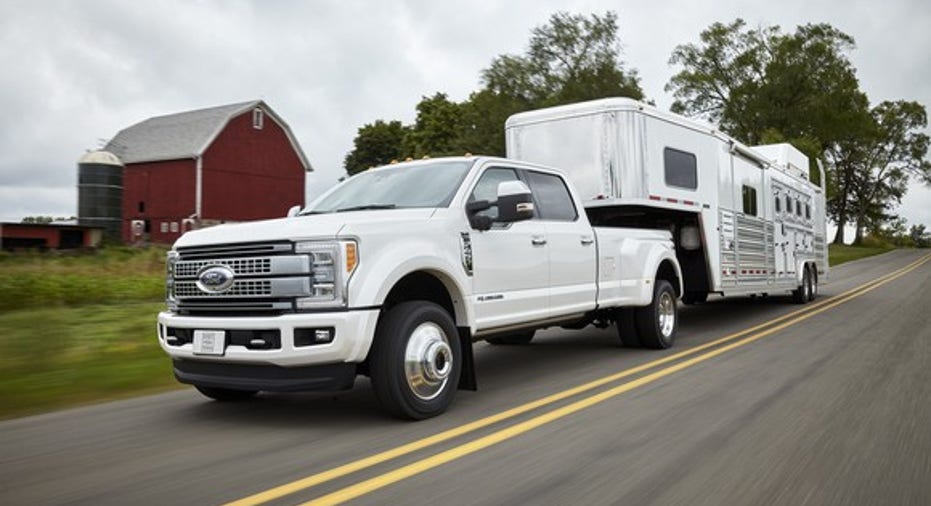Why Ford's New 2017 Super Duty Pickups Will Dent Its Profits

Ford has begun shipping its all-new 2017 Super Duty trucks to dealers. Image source: Ford Motor Company.
Ford Motor Company's (NYSE: F) big F-Series line of pickup trucks are probably its most important products. They sell in huge numbers and generate huge profits -- and they get a lot of attention from investors.
That means a lot of eyebrows were raised when Ford cautioned that the all-new version of its Super Duty pickups might cause its profits to dip for a while.
Wait. Don't new products make automakers' profits go up?
Generally speaking, that's true. When an all-new version of a model comes out, it can usually be sold with lower incentives than the outgoing model, at least for a while. That gives the automaker more profit per vehicle, and (usually) a boost big enough to be visible in its quarterly earnings report.
But Ford said that things will be different with the all-new 2017 Super Duty, because of the way that automakers account for the costs of developing new products -- and because the outgoing Super Duty dates back almost 20 years.
When an automaker develops a new model, it has to invest a huge amount of money before a single car or truck is sold. It has to pay for design, engineering, testing, and (usually the biggest expense) all of the specialized tooling and machinery it will need to manufacture the vehicle.
For accounting purposes, those costs are paid off over time, a little bit from each vehicle sold. Eventually, the investment is paid off -- and the product generates good profits for the remainder of its lifecycle.
In the case of the outgoing version of the Super Duty, its development and tooling costs were paid off a long time ago. Ford has given it a number of updates over the years, but the basic structure hasn't changed. That means the factory tooling hasn't had a lot of changes, and that means that Ford's per-truck profits on the Super Duty have been very big for a long time.
That's about to change.
A big hit in the third quarter, and added costs for a while longer
Before Ford launched the new-for-2015 F-150, it had to gut and completely retool the two factories that make the popular pickup. Each factory was closed for about 12 weeks to make the changes, costing Ford a total of about 90,000 units of production.
That was a huge, expensive product launch. The Super Duty launch won't be quite as expensive, in part because only one factory is involved, and in part because Ford will apply lessons it learned during the F-150's ramp-up. But it will still be a big deal, because the new Super Duty really is all-new and shares the F-150's aluminum body panels and other new features.
That will hit Ford's bottom line during the third quarter, as CFO Bob Shanks explained during Ford's second-quarter earnings call last month:
Shanks further explained that the new Super Duty will still have "among the best" profit margins of any Ford product. But the added costs versus the outgoing model will "flow through into the fourth quarter and the forward years" until Ford's investment is paid off.
The upshot for shareholders: Expect a weaker-than-usual third quarter
"Usually, the third quarter is about a quarter of our full-year results" in terms of profit in North America, Shanks said. "It's likely to be half of that or lower [in the third quarter of 2016], and that's largely around the F-Series effect."
If the U.S. market for trucks remains strong for another year or two, Ford may be able to offset some of the incremental cost with price increases (or put another way, smaller discounts). That may make the added cost of the Super Duty largely a wash from a Ford shareholder's perspective.
But Shanks was clear: Ford's third-quarter profit will be lower than we're used to seeing, and the very expensive new Super Duty trucks are the reason.
A secret billion-dollar stock opportunity The world's biggest tech company forgot to show you something, but a few Wall Street analysts and the Fool didn't miss a beat: There's a small company that's powering their brand-new gadgets and the coming revolution in technology. And we think its stock price has nearly unlimited room to run for early in-the-know investors! To be one of them, just click here.
John Rosevear owns shares of Ford. The Motley Fool owns shares of and recommends Ford. Try any of our Foolish newsletter services free for 30 days. We Fools may not all hold the same opinions, but we all believe that considering a diverse range of insights makes us better investors. The Motley Fool has a disclosure policy.